| Oracle® Enterprise Manager Ops Center Creating System Catalog Report Guide 12c Release 1 (12.1.1.0.0) Part Number E27348-02 |
|
| PDF · Mobi · ePub |
| Oracle® Enterprise Manager Ops Center Creating System Catalog Report Guide 12c Release 1 (12.1.1.0.0) Part Number E27348-02 |
|
| PDF · Mobi · ePub |
Creating System Catalog Report Guide
12c Release 1 (12.1.1.0.0)
E27348-02
June 2012
This guide provides an end-to-end example for how to use Oracle Enterprise Manager Ops Center.
A System Catalog Report provides information about the current state of the selected operating system. A System Catalog Report lists the current catalog of one or more systems. A system catalog contains a list of operating system software components that are installed on a managed system. Catalogs provide the capability to directly manipulate the installed software components on a single operating system or a group of operating systems.
After an operating system is available and selected, you can view and modify the catalogs, and create historical catalogs. Historical catalogs are snapshots of the system. The software automatically takes a snapshot of the operating system after running a job on the operating system, including when you discover and manage the operating system. A snapshot is stored as a catalog with the time stamp and job details after every update job that you run on a system.
You can create a new catalog at any time and use it to record the state of a system. Catalogs enables us to rollback our system to any previous configuration or to create a profile that is used to apply a consistent configuration throughout our datacenter.
The System Catalog reports on the installed patch state of operating system instances. Unlike the other report types, these are not run from the Reports drawer of the Navigation pane. They are generated and run from the Assets drawer of Navigation pane. The System Catalog Report shows all the patches, packages or RPMs that are installed on an operating system.
See Related Articles and Resources for links to report information and other examples.
This example shows you how to create a System Catalog Report on an Oracle Solaris operating system. You can view the report in an interactive view and the report result in PDF format.
You need the following before you can create a System Catalog Report:
A discovered and agent-managed Oracle Solaris 10 operating system.
Report administrator to create and complete the procedure for System Catalog Report.
The following steps define the procedure to successfully create a System Catalog Report on Oracle Solaris 10.
Navigate to the Assets drawer of Navigation pane and select an asset.
Click the System Catalog Report link from the Update section of the Actions pane.
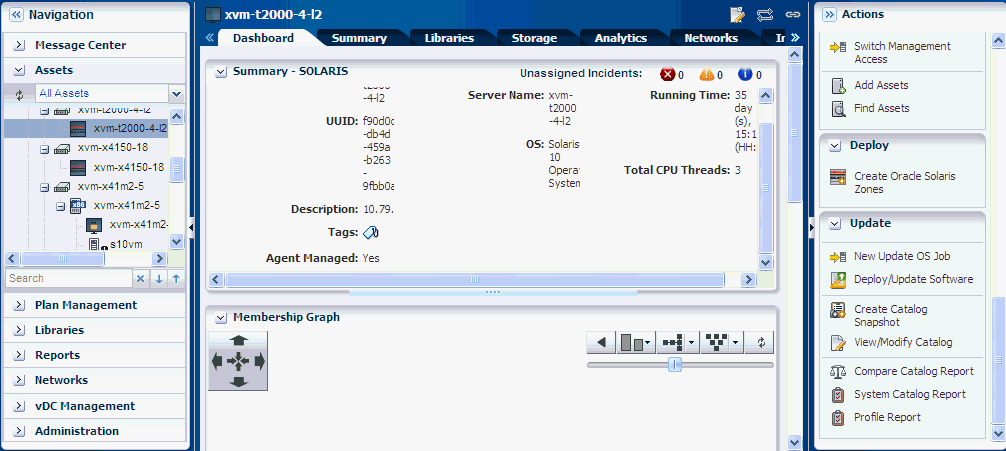
The System Catalog Report wizard is displayed.
Define the following report parameters, then click Next.
Report Name – The name of the report.
Description – A description of the report.
Schedule – Select Create Schedule to schedule the report.
Output Format – Select PDF as the output format of the report result.
Select Targets – The selected asset is displayed in the Add to Target List.
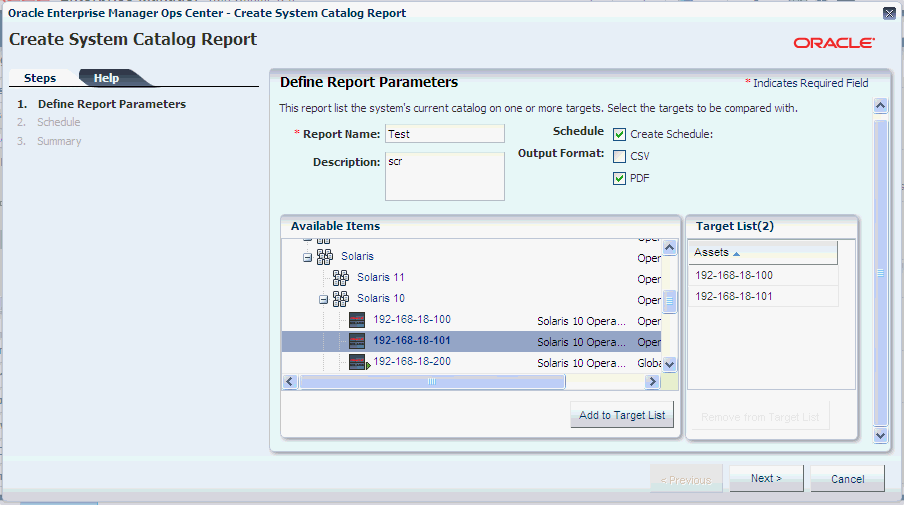
Select Now to generate the report, then click Next to display the Summary.
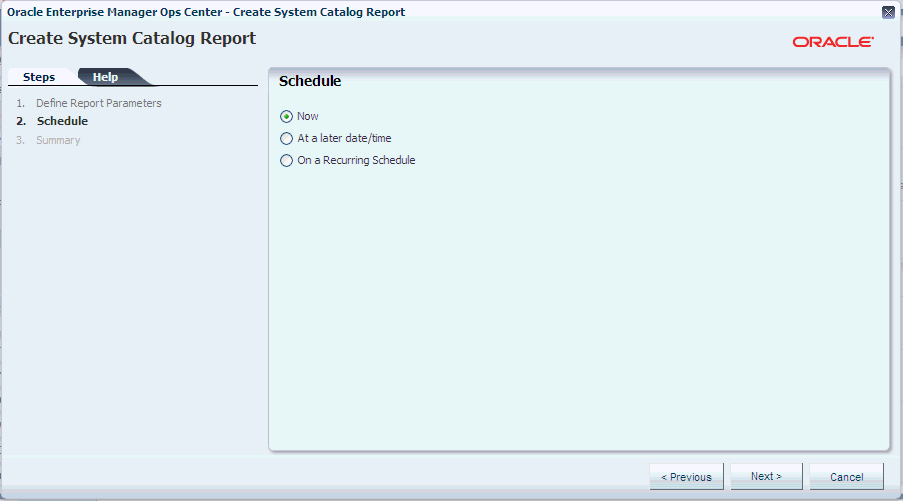
Click Run and Close to run the report.
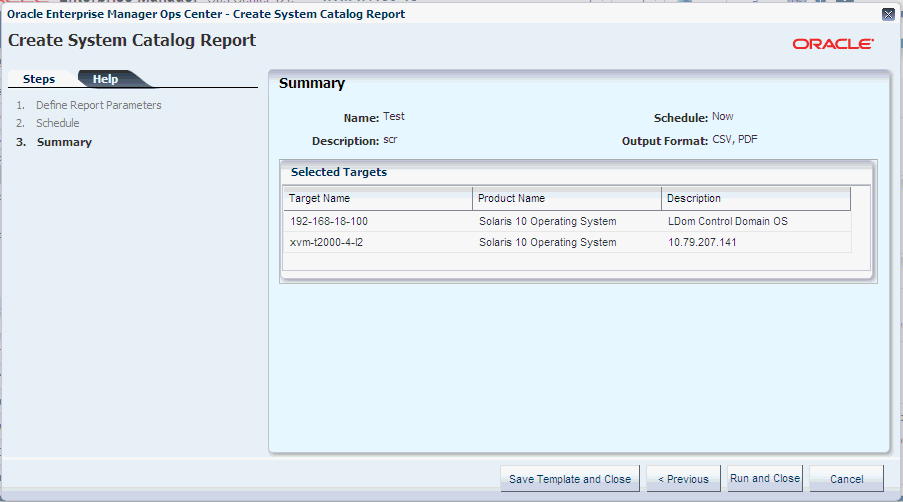
When the report completes, the results appear in a pop-up page.

After the report is generated, the Report Results pane lets you do the following:
Save the report result as a template – you can save the report as a template for future use.
Rerun the report – you can rerun the report to view the changes.
Extract a profile for the target – you can create an OS Update profile with the available patches/packages.
You can view the report from the Report Results section of the center pane. You can select a report and click PDF or CSV to view and export the report result. The figure below displays the PDF output of the report result.
You can view the report interactively. The View Interactive option enables you to view the generated report in detail. Report result displays the Report name, Report type, Run Date, Status, Targets of the Report, OS updates applicable to selected targets. Report parameters show the target name, product name, description. You can save the report as a template and also rerun the report.
Double-click the report in the Report Results section of the center pane to display the details of the generated System Catalog Report. It details out the summary of the report result and the detailed report result displaying the OS updates applicable to the selected targets.
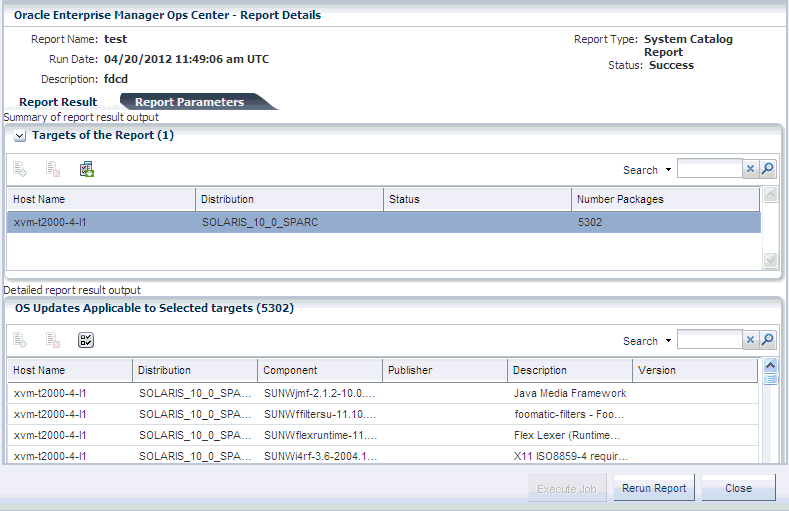
For more information on reports, see the following:
Oracle Enterprise Manager Ops Center Feature Reference Guide
Other examples of How Tos available at http://docs.oracle.com/cd/E27363_01/nav/howto.htm
For information about Oracle's commitment to accessibility, visit the Oracle Accessibility Program website at http://www.oracle.com/pls/topic/lookup?ctx=acc&id=docacc.
Oracle customers have access to electronic support through My Oracle Support. For information, visit http://www.oracle.com/pls/topic/lookup?ctx=acc&id=info or visit http://www.oracle.com/pls/topic/lookup?ctx=acc&id=trs if you are hearing impaired.
Oracle Enterprise Manager Ops Center Creating System Catalog Report Guide, 12c Release 1 (12.1.1.0.0)
E27348-02
Copyright © 2007, 2012, Oracle and/or its affiliates. All rights reserved.
This software and related documentation are provided under a license agreement containing restrictions on use and disclosure and are protected by intellectual property laws. Except as expressly permitted in your license agreement or allowed by law, you may not use, copy, reproduce, translate, broadcast, modify, license, transmit, distribute, exhibit, perform, publish, or display any part, in any form, or by any means. Reverse engineering, disassembly, or decompilation of this software, unless required by law for interoperability, is prohibited.
The information contained herein is subject to change without notice and is not warranted to be error-free. If you find any errors, please report them to us in writing.
If this is software or related documentation that is delivered to the U.S. Government or anyone licensing it on behalf of the U.S. Government, the following notice is applicable:
U.S. GOVERNMENT END USERS: Oracle programs, including any operating system, integrated software, any programs installed on the hardware, and/or documentation, delivered to U.S. Government end users are "commercial computer software" pursuant to the applicable Federal Acquisition Regulation and agency-specific supplemental regulations. As such, use, duplication, disclosure, modification, and adaptation of the programs, including any operating system, integrated software, any programs installed on the hardware, and/or documentation, shall be subject to license terms and license restrictions applicable to the programs. No other rights are granted to the U.S. Government.
This software or hardware is developed for general use in a variety of information management applications. It is not developed or intended for use in any inherently dangerous applications, including applications that may create a risk of personal injury. If you use this software or hardware in dangerous applications, then you shall be responsible to take all appropriate fail-safe, backup, redundancy, and other measures to ensure its safe use. Oracle Corporation and its affiliates disclaim any liability for any damages caused by use of this software or hardware in dangerous applications.
Oracle and Java are registered trademarks of Oracle and/or its affiliates. Other names may be trademarks of their respective owners.
Intel and Intel Xeon are trademarks or registered trademarks of Intel Corporation. All SPARC trademarks are used under license and are trademarks or registered trademarks of SPARC International, Inc. AMD, Opteron, the AMD logo, and the AMD Opteron logo are trademarks or registered trademarks of Advanced Micro Devices. UNIX is a registered trademark of The Open Group.
This software or hardware and documentation may provide access to or information on content, products, and services from third parties. Oracle Corporation and its affiliates are not responsible for and expressly disclaim all warranties of any kind with respect to third-party content, products, and services. Oracle Corporation and its affiliates will not be responsible for any loss, costs, or damages incurred due to your access to or use of third-party content, products, or services.